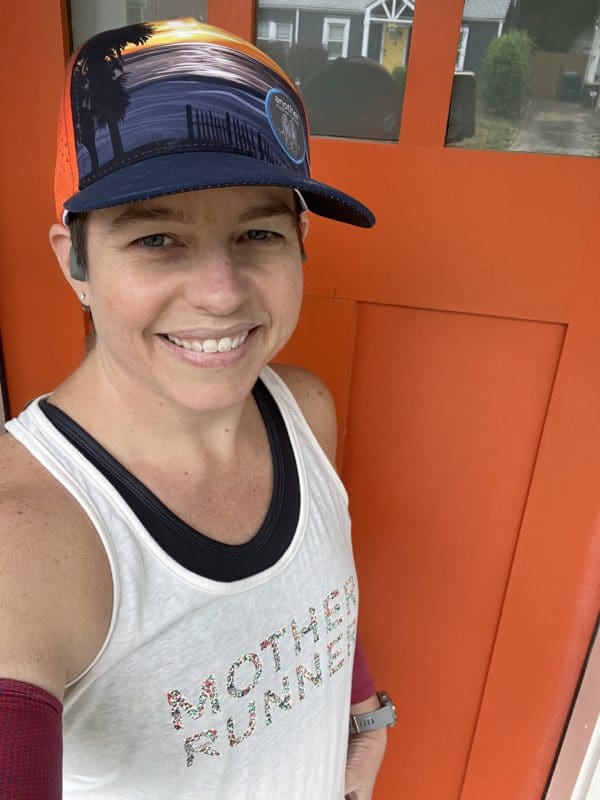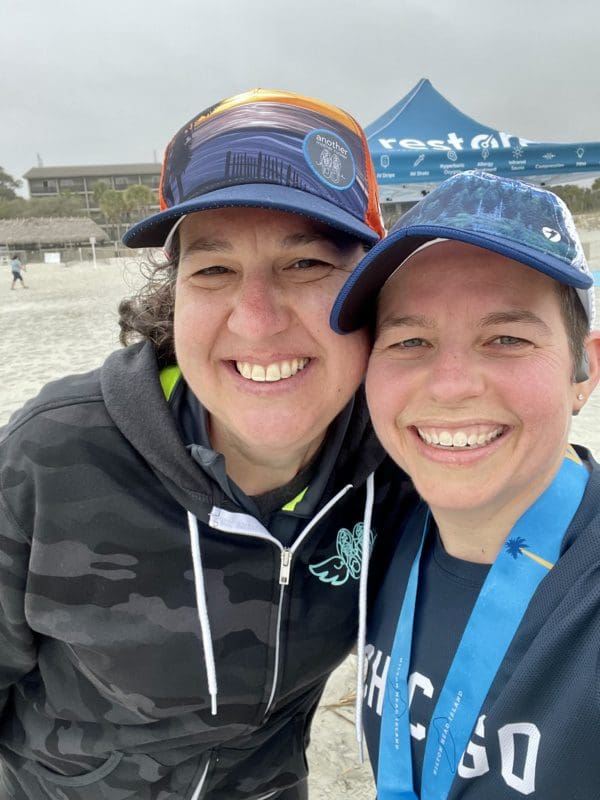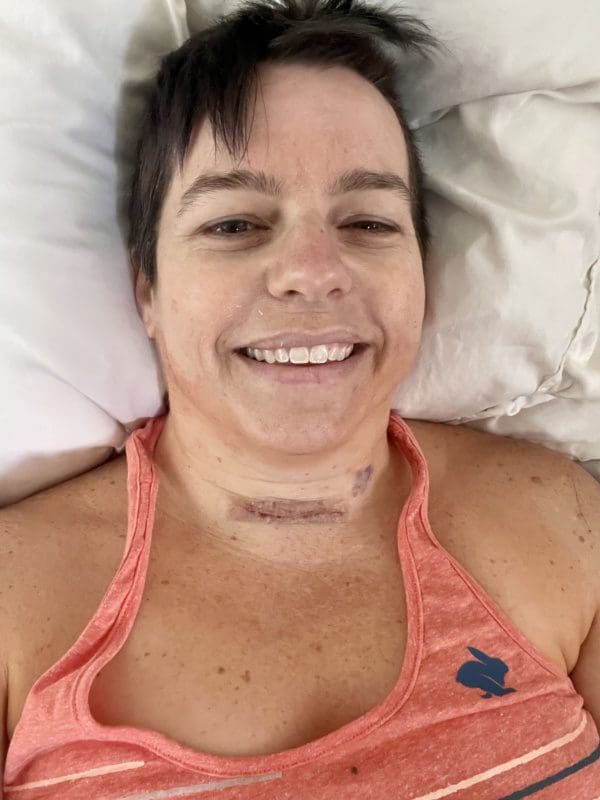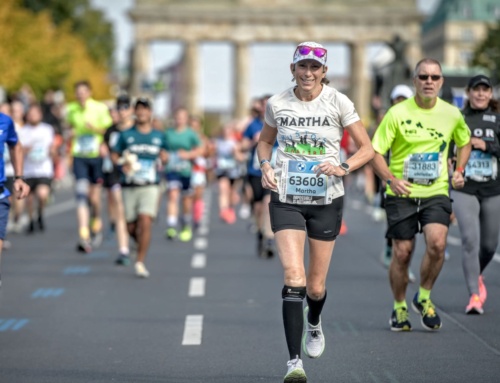We have a routine
I feel weird about my neck. Not bad, but weird.
Until recently, my neck was just the connector of head and chest, housing bits of spine, larynx, esophagus, vocal folds – and thyroid. The thyroid is a small, butterfly-shaped organ that plays a starring role in regulating energy and metabolism.
Everything in my neck has always been present and accounted for, functioning more or less normally. Sure, my thyroid started accumulating some bumps and lumps along the way, but what body part hasn’t by middle age?

Nothing to see here folks: just an ordinary neck
Once a year or so, my endocrinologist takes a closer look at those thyroid issues and nodules. We have a routine. She does an ultrasound, then says, “Hmm, this one looks a little wonky. I think we need to do a biopsy.” She uses a fine needle to extract a bit of tissue from that day’s offending nodule(s) and sends it off for testing. The testing comes back inconclusive, so it’s sent along for further—and significantly more expensive—genetic testing that takes a few weeks. I spend those weeks on the edge of anxiety, mentally killing myself off with any number of rare cancers. My doctor finally calls and says that everything is fine after all, and life continues as normal.
In fact, this has become so routine, that during this last round, I couldn’t even be bothered to summon up more than the mildest bit of worry. And that only was for a day or two.
When the routine goes off-script
Well. I can tell you I won’t make that mistake again. Because this time around when my phone rang, my endocrinologist went off script.
“The genetic results came in, and I’m sorry to tell you that they indicate either thyroid cancer or cells that will eventually become cancerous. It’s about a 50% chance of cancer. We’re going to have to remove your thyroid.”
This is where I began to feel weird about my neck. Once a conduit from head to body, my neck is now housing for what my boss has dubbed Schrodinger’s cancer: something that is both cancer and not cancer until the container is opened.

Everyone should have a support network like this
The month between the phone call and my surgical consult felt like it lasted at least a year. I spent the time rallying the troops – family, local friends, BAMR network (including Cynthia, thyroid and running gear guru), strength trainer, therapist – and handling my anxiety through running, eating chocolate, lifting, eating Dots pretzels, breathing, drinking G&Ts, reading trashy novels, eating chocolate, and screaming into the void.
Okay, but what does this mean for my running?
My endocrinologist had initially tended toward removing the whole thyroid, but when I expressed concerns about how that might affect my life as an endurance athlete, she pivoted to a lobectomy. It turns out that most people respond well to synthetic thyroid hormones, while an unlucky few experience unmitigated malaise. As yet, there is no way to predetermine who will be tired all the time and who can continue running marathons.

Fellow BAMRbassador Cynthia is a wealth of thyroid knowledge and support
My surgeon, a marathon runner himself, concurred. And—bonus—he implicitly understood what physical movement means to my physical and mental well being. “You’d be safe to run the day after surgery. You won’t want to. But you can. I do recommend daily outdoor walks, though. And when you do start to run, maybe think about switching up your three-mile loop for a one-mile loop. You can do three miles, but if you tire out, you won’t be stuck.” He also made sure to caveat the no-lifting-for-two-weeks rule with, “that includes body weight exercises!”
Things get real, real fast
I went into the surgery with the alternating convictions that:
- I was going to die on the operating table. (It’s okay to laugh here; I laughed at myself!)
- I was going to come out feeling better than ever.
- The surgeon would find all sorts of unexpected cancer and give me a few months to live.
- Everything would be fine but I’d need some sort of thyroid replacement therapy.
The first and third scenarios were wildly improbable and, thankfully, did not come to pass. I’m still awaiting the final pathology, which is frustrating to say the least.

We hope you don’t ever need to know, but in case you do, this is what thyroid surgery looks like a few hours after.
What I do know is that it’s nothing dire, but I’m still left with a spectrum of possibilities that range from “my thyroid functions just fine and there is no need for further intervention at this time” all the way to “there is a very slow-moving cancer that will require near-term removal of my remaining thyroid lobe plus iodine therapy.”
Settling into a new routine
What I also know is that my body continues to recover in an awe-inspiring fashion. Three weeks ago I had half an organ removed and struggled to walk the surgeon-prescribed 20 minutes. Two weeks ago I could walk two miles. One week ago I could add in some hills plus struggle through most of the workday. Running caused pain at my incision and was a non-starter. Today I can manage a handful of slow jog intervals plus a full workday.

All the cool kids have a smile-shaped neck scar!
I continue to feel weird about my neck. While I don’t feel self-conscious from a vanity standpoint, I feel like the scar preempts any desire I might have had for privacy. It’s like some kind of secular sacrament I didn’t necessarily consent to: an outward symbol of an inward change. It is, however, a (somewhat jarring) reminder that life and lifestyle may be fleeting, so live in gratitude and joy, hug my people in close, and gather my rosebuds while I may.






A month ago, I had the same surgery. Today I am feeling great. I am getting back into running slowly, but I have no doubt that I will get back to the miles I am used to. The support I had around me was second to none and it was not cancer. The waiting was the worst part. Thank you for sharing your story.
I’m sorry you had to go through that, Nicole. Having that kind of support makes a world of difference. And hooray for not cancer – what great news!
Pam, so mNy thoughts….First I am so sorry you went through this. My MIL had her thyroid completely removed a few years ago and did the radiation treatment for cancer. So, I’m tangent familiar.
But personally I get you on two levels. In 2019 I had a breat cancer scare that required an excisiinal biopsy, aka a lumpectomy if they knew it was cancer. They didn’t, so it got a different name.your boss gave it. It feels so spot on.
And as far as conspicuous scar, I see you there too. I had a chunk of basal cell carcinoma removed from my left temple this winter. The scar felt so huge and obvious. But I bet ypu didn’t notice it this spring. I used some scar strips to fade the color. But really, like spots on our shirt, we see them more than others. Soon it will just be your neck again
Hoping for good news on the pathology. ❤️
Love you PAMR!
Pam, so sorry to hear this. Thank you for sharing your experience. Sending positive, healthy happy vibes your way!
Pam! I wish I had known this when we were in Hilton Head! As I type this I’m waiting for a round of genetic testing to come back on one of my thyroid “lumps” from my biopsy that was done two weeks ago. I have hyperthyroidism and this is my 2nd biopsy. I am fascinated that you only had part of yours removed. I have rejected having mine removed even though it’s been offered multiple times and it’s largely because I don’t want to lose my entire thyroid which is still basically working. I don’t want to have my exercise/running routing destroyed!
Whatever the future holds, I have no doubt you will tackle it with the same grace and grit you have brought to the other challenges in running and life that you have so generously and eloquently shared throughout the years!
I had the lumps until the doc decided half needed to come out. I wish I’d had the whole thing out bc I still needed the thyroid meds (there is more than just synthroid FYI, so if you need meds it’s ok and don’t be afraid to ask to change if one type doesn’t seem to work!) and I now have lumps on the other half, so it will have to come out at some point. BUT I still can run. My endurance isn’t always great, but it’s getting better as I’m figuring out my body and what it needs. Whatever the outcome of your surgery, don’t let it derail you! Best of luck with your recovery!!
I had mine radiated over 30 years ago- so no thyroid. I have completed 143 triathlons (two IMs and 8 70.3s) along with plenty of mountain/road bike races, swims from Alcatraz and working with a 60+ caseload of preschoolers. I found a good endocrinologist who got me on the right meds and really never gave it much thought as the Graves Disease was killing my ability to work/mom/workout big time- and now I could! Glad you are back “at it”- watch those biopsies however. Sometimes they are unnecessary and actually can cause problems!
Oh my goodness! What a ride! I was diagnosed with Hashimoto’s recently, thanks to my PSYCHIATRIST because my PCP had not taken into account different mental health issues that cause regular blood work to be inconclusive!!! I am still amidst the process but have been taking a lot of information on – I highly recommend Thyroid Strong a program run by an old high school classmate and good friend. She is a chiropractor by trade but has an amazing story – and client list that solidified my life long trust in her. Also, for anyone in the process, following an Auto Immune Protocol Diet has helped immensely along with medication (and doctor’s orders).
Thank you for sharing your story – this is definitely a developing field that they are only just learning about – imagine, 50 years ago we would have just been considered hysterical. Go figure, there is something going on!
The timing of this is so appropriate. I had a left thyroid lobectomy in February to remove a nodule. But the nodule came back as cancerous, so I just had the rest of my thyroid removed on May 21. I’m walking right now, haven’t ventured back to running yet. I find I have headaches and I’m so tired right now. But I just started taking a much higher dose of Synthroid yesterday, since I don’t have any thyroid tissue left to make it for me. But it’s been a whirlwind of emotions… I’ve had 2 thyroid surgeries in 3 months and have magically gone from just normal me to now the cancer survivor version of me. I still have to wait a few more months to have my thyroglobulin tested. If there is evidence of that in my system in August, then that means there is still some thyroid cancer cells in my body that are making thyroglobulin, so I’ll need other treatment too, most likely in the form of radioactive iodine.
Good luck in your healing, I just got a lot of comfort seeing this subject come up right now… because I’m just beat and I really want to run but I’m not there yet!
Wow, so timely! I just had a total thyroidectomy on 5/27. My biopsies all came back benign but the nodules got so big that it had to come out. I can relate to so much of what you wrote! What about my running?? – that was a frequent question at the various doctor visits. And the fear that I would be among the “unlucky few” – really scary. I also had this bizarre idea that I would die, but I’ve since heard that many people facing major surgery have that.
I kept my upcoming surgery private for a long time. I am not sure why. Then at some point, I wanted people to know and I posted about it on Facebook. I am really glad I did because the outpouring of support has been amazing!
I connected with Cynthia also at the Hilton Head retreat. My thyroid cancer was about 25 years ago when I was in my mid 20’s. The first doctor missed it with the biopsy. Thankfully the second one caught it. I ended up having two surgeries back to back. The hardest part was getting the meds right with how I felt. Hang in there, it is scary but sounds like you have good doctors (and all of us BAMR’S!)
Hi Pam,
I had half my thyroid removed too, about 7 years ago. I had nodules that were too big, the fine needle biopsy was inconclusive, so it had to come out. I too didn’t know if it was cancerous or not until a week or so after my surgery!! It’s true the waiting can be the hardest part!! I agree with Amy above about the meds. If what they put you on first doesn’t work, ask for something different. I started on Synthroid, but when that seemed to not help anymore I was given something additional (t3 maybe?). Later I switched to Nature-Throid, which worked well, but was more difficult to find. When THAT was discontinued, I gave Synthroid another try. Which seems to work, for now! I hope that you have an endo that goes more by how you feel rather than just your testing numbers. It was tough for me getting back into running shape, but I finally did. The fall after my surgery, I ran the Chicago Marathon. Well, half of it! I didn’t have enough time to complete marathon training, but I did get in 13.1. Cutting back to the start, I got some looks of pity, people who didn’t know I had “dropped out” on purpose! I was just happy and satisfied to complete what I did! Best of luck to you.
Ugh, Schrodinger’s cancer… I feel that big time! I had what was apparently a massive nodule on my thyroid that went unchecked for quite some time through pregnancies and early motherhood. I had an ultrasound and a biopsy, which came back questionable. The most nerve-wracking thing was that these discussions were happening in March 2020, and there was debate over whether or not to push off the surgery due to the early days of the pandemic. Hearing my care team recommend I keep my March 31 surgery date had me terrified—if it couldn’t wait, it was definitely going to kill me (according to my anxiety anyway). After discussing with my endocrinologist and surgeon, we opted to remove half of my thyroid, biopsy it on the table, and decide if they’d remove the whole thing if it came back cancerous. Wouldn’t you know, the large nodule was benign, but there were other spots that “were” cancerous! I see my endo and do labs every 6 months, and they’ve all come back clean *knock on wood* I take thyroid hormones every day and though my levels are good, I’m still so tired. Thanks to another commenter, I’m going to ask about other types of medication! It took me a long time to get back into running and exercising (the pandemic and a new baby didn’t help, either) but I’m back in a half marathon training cycle and stoked about it.
Here’s to speedy healing and getting the answers you need!
My sister had half her thyroid removed a few years ago and is doing fantastic.
I will have nearly half of my upper jaw (maxilla) removed along with 3 teeth attached to it at the end of this month. They will take 8″ of my fibula to fashion a new maxilla. So I get all of this. I thought I had an abscessed tooth.
Also have been on thyroid meds for a few years due to hypothyroid.
My understanding is that we will both be able to do whatever we want, when we recover! So I’m holding out my best hopes for you, Pamr!
It has been a long time. It is awesome to see you pickup a sport that I have loved for years and excel in it! Your tenacity and grit that brought you through life and running will also bring you through this, I am confident!
YFB
[…] two months ago I had thyroid surgery to remove half said thyroid, and life since then has been…interesting. The same kind of […]
[…] Beating up on things felt like the perfect outlet for the frustration and fear I experienced from thyroid surgery and its aftermath (cancer diagnosis, wild mood swings, weight gain, loss of fitness and endurance, […]